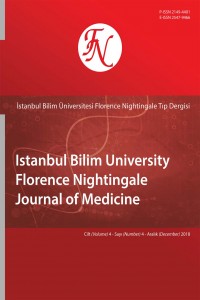Abstract
Polifenoller bitkilerin kök, tohum, çiçek, yaprak, dal ve gövde gibi tüm kısımlarında ve yeşil çay, kahve, kakao, böğürtlen, ahududu, çilek, nar, üzüm gibi bitkisel ürünlerde yüksek miktarlarda bulunurlar. Polifenollerin antioksidan, antikanser, anti-inflamatuar, antikoagülan ve antimikrobiyal etkileri olduğunu belirten araştırmalar bulunmaktadır. Son yıllarda araştırmacılar bu bileşiklerin anti-kanser etkisinde rol alan moleküler mekanizmaların aydınlatılmasına yönelmiştir. Ancak, hem etki mekanizmalarının kanser hücre tipine göre farklılık göstermesi hem de biyoyararlanımlarının sınırlı olması, biyoyararlanımı artıracak ve kanser hücre tipine spesifik yaklaşımların geliştirilmesini gerekli kılmaktadır. Bu derlemede özellikle polifenolden zengin bitki ürünlerinin, normalde inhibitör özellikteki IkB proteini ile bağlı halde bulunan ve böylece inaktif halde tutulan nükleer faktör-kappa B proteinine olan etki mekanizmaları tartışılmıştır.
References
- 1. Cragg GM, Newman DJ. Plants as a source of anti-cancer agents. J Ethnopharmacol 2005;100:72-9.
- 2. World Cancer Report 2014, In: Stewart BW, Wild CP, editors. Lyon, 2014. Available from: http://publications.iarc.fr/Non Series-Publications/World-Cancer-Reports/World-Cancer-Report-2014
- 3. Steinmetz KA, Potter JD. Vegetables, fruit, and cancer. II. Mechanisms. Cancer Causes Control 1991;2:427-42.
- 4. Ziegler RG, Colavito EA, Hartge P, McAdams MJ, Schoenberg JB, Mason TJ, et al. Importance of alpha-carotene, beta-carotene, and other phytochemicals in the etiology of lung cancer. J Natl Cancer Inst 1996;88:612-5.
- 5. Amin AR, Kucuk O, Khuri FR, Shin DM. Perspectives for cancer prevention with natural compounds. J Clin Oncol 2009;27:2712-25.
- 6. Hussain SA, Sulaiman AA, Balch C, Chauhan H, Alhadidi QM, Tiwari AK. Natural Polyphenols in Cancer Chemoresistance. Nutr Cancer 2016;68:879-91.
- 7. Farzaei MH, Bahramsoltani R, Rahimi R. Phytochemicals as Adjunctive with Conventional Anticancer Therapies. Curr Pharm Des 2016;22:4201-18.
- 8. Manach C, Scalbert A, Morand C, Rémésy C, Jiménez L. Polyphenols: food sources and bioavailability. Am J Clin Nutr 2004;79:727-47.
- 9. Beecher GR. Overview of dietary flavonoids: nomenclature, occurrence and intake. J Nutr 2003;133:3248-54.
- 10. Croft KD. The chemistry and biological effects of flavonoids and phenolic acids. Ann N Y Acad Sci 1998;854:435-42.
- 11. Rodrigo R, Libuy M, Feliu F, Hasson D. Polyphenols in disease: from diet to supplements. Curr Pharm Biotechnol 2014;15:304-17.
- 12. Gupta RK, Patel AK, Shah N, Chaudhary AK, Jha UK, Yadav UC, et al. Oxidative stress and antioxidants in disease and cancer: a review. Asian Pac J Cancer Prev 2014;15:4405-9.
- 13. Yalçın AS. Antioksidanlar. Klin Gel 1998;11:342-6.
- 14. Aktan AÖ, Yalcın AS. Ischemia-reperfusion injury, reactive oxygen metabolites, and the surgeon. Turkish J Med Sci 1998;28:1-5.
- 15. Wang HK. The therapeutic potential of flavonoids. Expert Opin Investig Drugs 2000;9:2103-19.
- 16. Wahyudi S, Sargowo D. Green tea polyphenols inhibit oxidized LDL-induced NF-KB activation in human umbilical vein endothelial cells. Acta Med Indones 2007;39:66-70.
- 17. Chahar MK, Sharma N, Dobhal MP, Joshi YC. Flavonoids: A versatile source of anticancer drugs. Pharmacogn Rev 2011;5:1-12.
- 18. Choi BH, Kim W, Wang QC, Kim DC, Tan SN, Yong JW, et al. Kinetin riboside preferentially induces apoptosis by modulating Bcl-2 family proteins and caspase-3 in cancer cells. Cancer Lett 2008;261:37-45.
- 19. Min KJ, Kwon TK. Anticancer effects and molecular mechanisms of epigallocatechin-3-gallate. Integr Med Res 2014;3:16-24.
- 20. da Silva J, Herrmann SM, Heuser V, Peres W, Possa Marroni N, González-Gallego J, et al. Evaluation of the genotoxic effect of rutin and quercetin by comet assay and micronucleus test. Food Chem Toxicol 2002;40:941-7.
- 21. Bossola M, Pacelli F, Tortorelli A, Rosa F, Doglietto GB. Skeletal muscle in cancer cachexia: the ideal target of drug therapy. Curr Cancer Drug Targets 2008;8:285-98.
- 22. Marshall EE, Geballe AP. Multifaceted evasion of the interferon response by cytomegalovirus. J Interferon Cytokine Res 2009;29:609-19.
- 23. Mingyan Y, Xinyong L, De Clercq E. NF-kappaB: the inducible factors of HIV-1 transcription and their inhibitors. Mini Rev Med Chem 2009;9:60-9.
- 24. Sheller JR, Polosukhin VV, Mitchell D, Cheng DS, Peebles RS, Blackwell TS. Nuclear factor kappa B induction in airway epithelium increases lung inflammation in allergen-challenged mice. Exp Lung Res 2009;35:883-95.
- 25. Chaturvedi MM, Sung B, Yadav VR, Kannappan R, Aggarwal BB. NF-kB addiction and its role in cancer: 'one size does not fit all’. Oncogene 2011;30:1615-30.
- 26. Napetschnig J, Wu H. Molecular basis of NF-kB signaling. Annu Rev Biophys 2013;42:443-68.
- 27. Dolcet X, Llobet D, Pallares J, Matias-Guiu X. NF-kB in development and progression of human cancer. Virchows Arch 2005;446:475-82.
- 28. Garg A, Aggarwal BB. Nuclear transcription factor-kappaB as a target for cancer drug development. Leukemia 2002;16:1053-68.
- 29. Bharti AC, Aggarwal BB. Nuclear factor-kappa B and cancer: its role in prevention and therapy. Biochem Pharmacol 2002;64:883-8.
- 30. Jones DR, Broad RM, Comeau LD, Parsons SJ, Mayo MW. Inhibition of nuclear factor kappaB chemosensitizes non-small cell lung cancer through cytochrome c release and caspase activation. J Thorac Cardiovasc Surg 2002;123:310-7.
- 31. Rundall BK, Denlinger CE, Jones DR. Combined histone deacetylase and NF-kappaB inhibition sensitizes non-small cell lung cancer to cell death. Surgery 2004;136:416-25.
- 32. Beg AA, Sha WC, Bronson RT, Ghosh S, Baltimore D. Embryonic lethality and liver degeneration in mice lacking the RelA component of NF-kappa B. Nature 1995;376:167-70.
- 33. Georgiev V, Ananga A, Tsolova V. Recent advances and uses of grape flavonoids as nutraceuticals. Nutrients 2014;6:391-415.
- 34. Xia EQ, Deng GF, Guo YJ, Li HB. Biological activities of polyphenols from grapes. Int J Mol Sci 2010;11:622-46.
- 35. Zhou K, Raffoul JJ. Potential anticancer properties of grape antioxidants. J Oncol 2012;2012:803294.
Details
| Primary Language | Turkish |
|---|---|
| Journal Section | Review |
| Authors | |
| Publication Date | January 3, 2019 |
| Published in Issue | Year 2018 Volume: 4 Issue: 4 |

